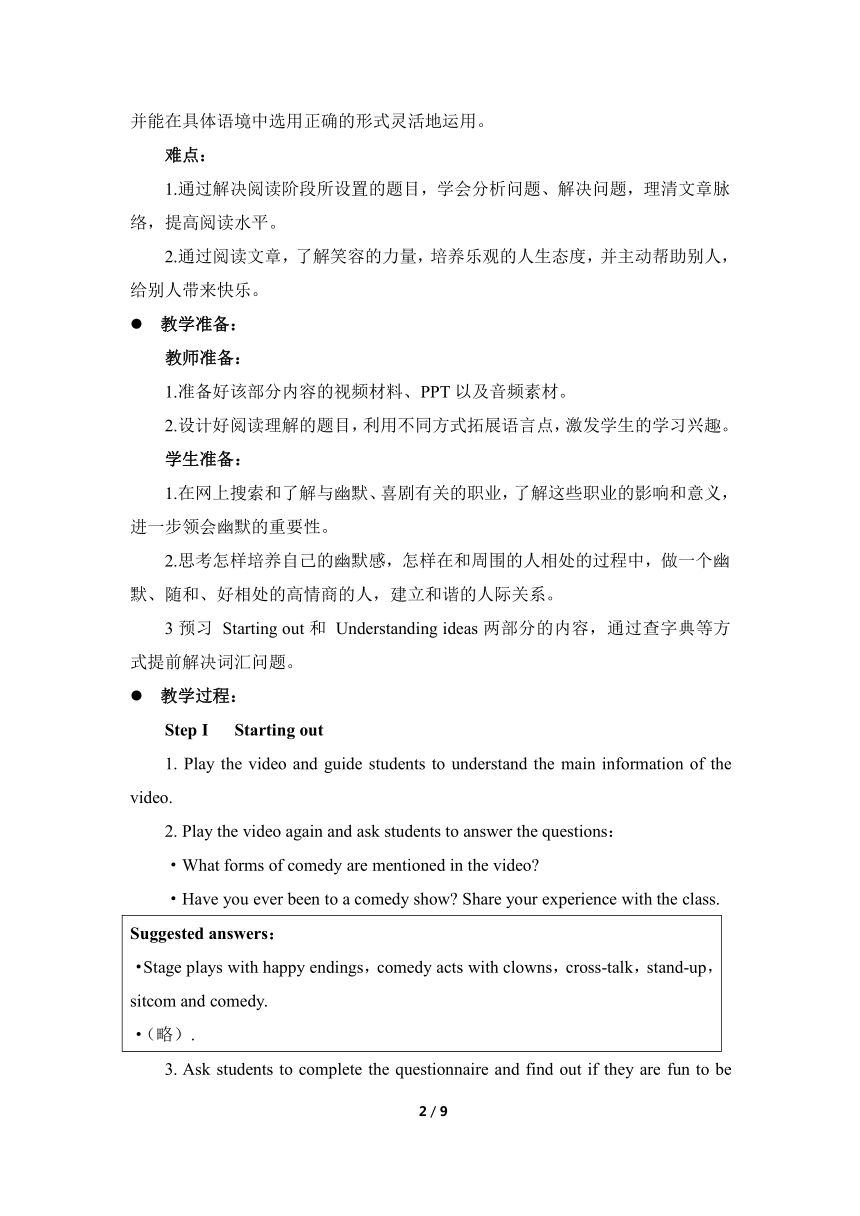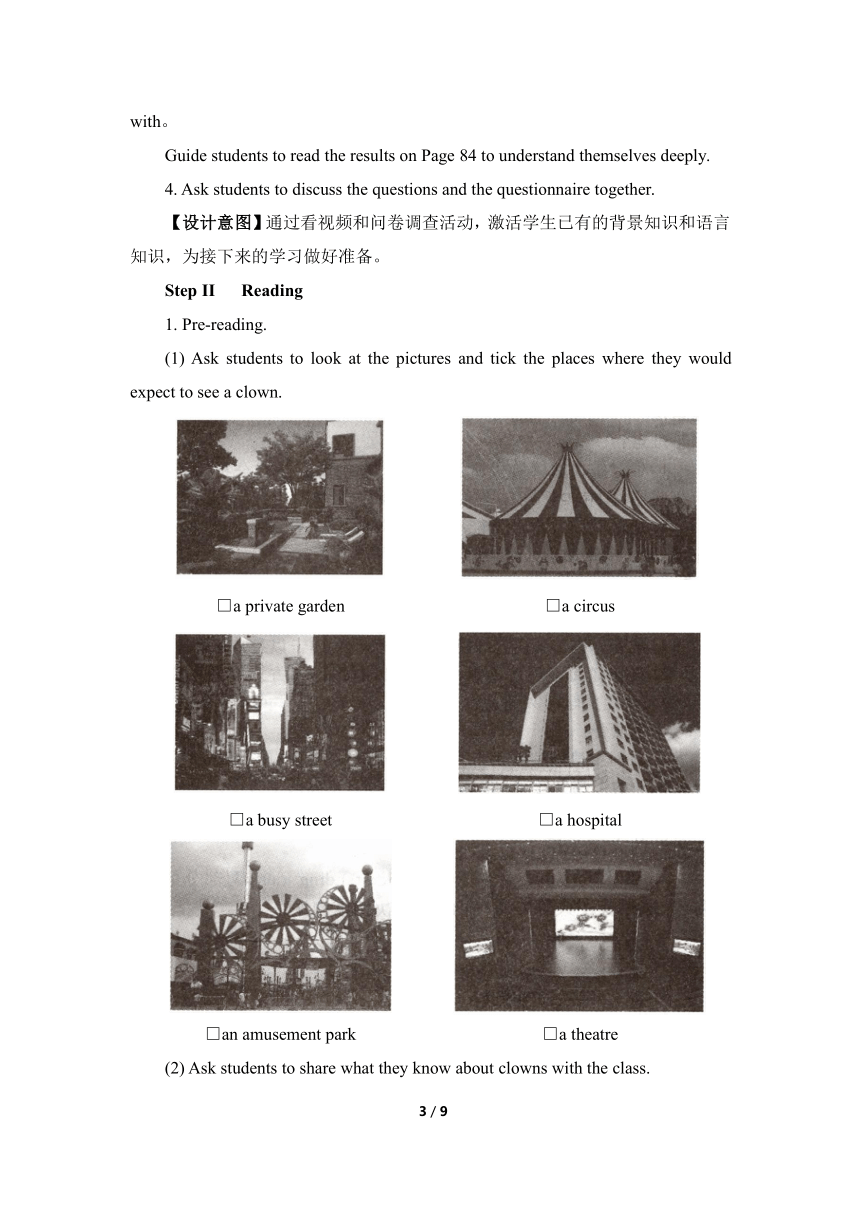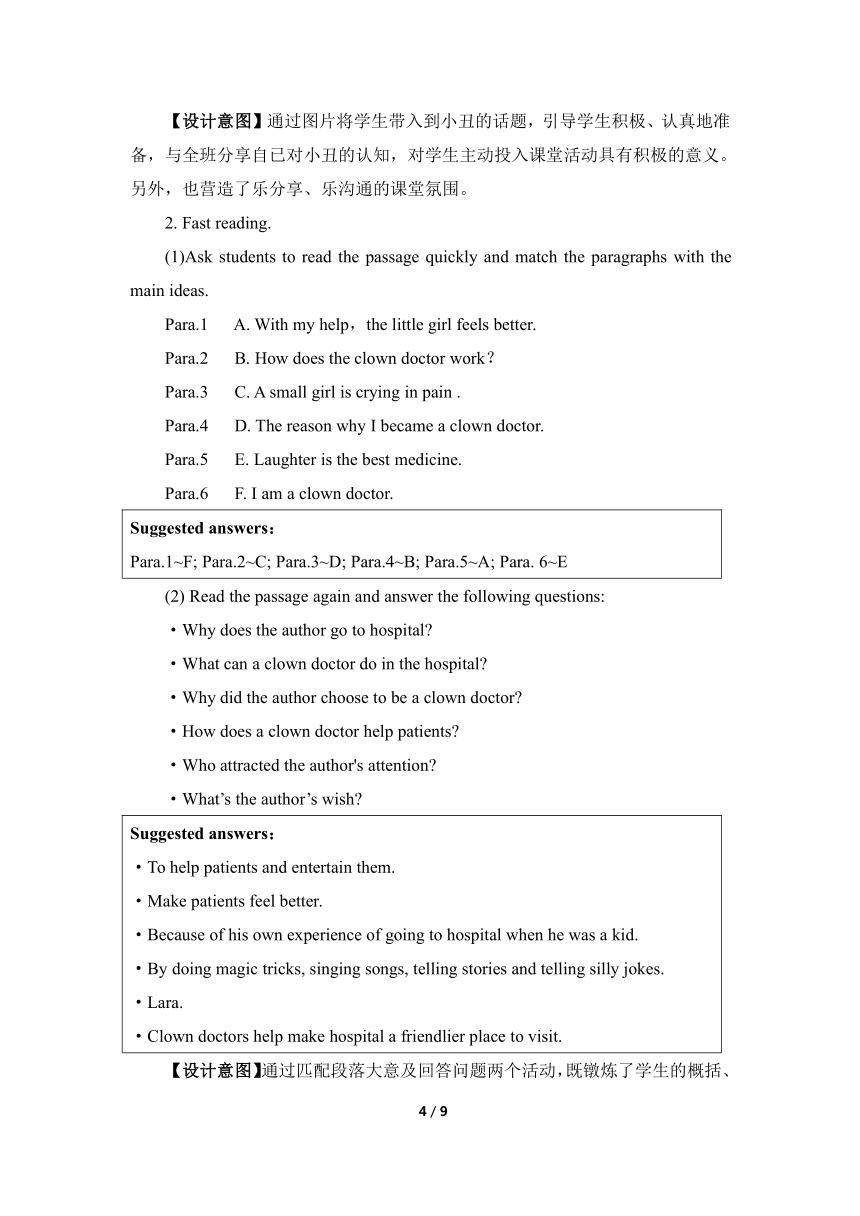外研版(2019)高中英语选择性必修第一册 Unit1 Laugh out loud! Starting out and Understanding ideas 名师教学设计
文档属性
| 名称 | 外研版(2019)高中英语选择性必修第一册 Unit1 Laugh out loud! Starting out and Understanding ideas 名师教学设计 |  | |
| 格式 | docx | ||
| 文件大小 | 2.8MB | ||
| 资源类型 | 教案 | ||
| 版本资源 | 外研版(2019) | ||
| 科目 | 英语 | ||
| 更新时间 | 2023-03-02 09:14:18 | ||
图片预览




文档简介
Unit 1 Starting out & Understanding ideas 名师教学设计
课时内容:
本课时包括 Starting out和 Understanding ideas两部分。
Starting out是导入部分,包括观看视频回答问题和问卷调查两个环节。通过视频引入喜剧发展的话题并让学生分享自己曾看过的喜剧表演的经历。问卷调查是测验学生的情商以及处事的幽默感,课本84页的问卷参考结果,告诉大家哪种结果更倾向于乐观、积极的趣味人生。通过两个练习活动,将学生们迅速带入喜剧以及幽默的话题中,为后面的学习热身,做好准备。
Understanding ideas部分以第一人称的方式介绍了一种职业—clown doctor。作者是一名小丑医生,工作的内容是换上小丑的行头,唱歌、跳舞、做各种滑稽表演,给病人、病人家属以及医护人员们减轻痛苦,带来快乐。通过该文章的学习,让学生理解“笑”的魅力和力量,尽己所能,给别人带来笑声,让自己的人生更有意义。
课时目标:
1.认知并灵活运用本课时的重点单词mood、amusement、entertain、examine、advertisement、employer与短语 cheer up、do the trick、apologise for、get lost、look through、In pain、be designed for、concentrate on、in turn、take off,after all,in need of 等。
2.通过速读、精读等方式掌握不同的阅读技巧和方法,引导学生由浅入深,逐层推进,加深对文章的理解。通过对所设置题目的解答,让学生学会根据关键词提取信息,理清文章线索,并学会深层次分析问题,进行语言加工,提高归纳概括、推理判断的能力。
3.通过阅读文章,学生可以开拓视野,丰富生活经验并体会到“助人度己”的积极生活态度的重要性。
重点难点:
重点:
学习、掌握本课的重点词汇mood、amusement、entertain、examine、advertisement、employer,cheer up、do the trick、apologise for、get lost、look through、In pain、be designed for、concentrate on、in turn、take off、after all、in need of等,并能在具体语境中选用正确的形式灵活地运用。
难点:
1.通过解决阅读阶段所设置的题目,学会分析问题、解决问题,理清文章脉络,提高阅读水平。
2.通过阅读文章,了解笑容的力量,培养乐观的人生态度,并主动帮助别人,给别人带来快乐。
教学准备:
教师准备:
1.准备好该部分内容的视频材料、PPT以及音频素材。
2.设计好阅读理解的题目,利用不同方式拓展语言点,激发学生的学习兴趣。
学生准备:
1.在网上搜索和了解与幽默、喜剧有关的职业,了解这些职业的影响和意义,进一步领会幽默的重要性。
2.思考怎样培养自己的幽默感,怎样在和周围的人相处的过程中,做一个幽默、随和、好相处的高情商的人,建立和谐的人际关系。
3预习 Starting out和 Understanding ideas两部分的内容,通过查字典等方式提前解决词汇问题。
教学过程:
Step I Starting out
1. Play the video and guide students to understand the main information of the video.
2. Play the video again and ask students to answer the questions:
·What forms of comedy are mentioned in the video
·Have you ever been to a comedy show Share your experience with the class.
Suggested answers: ·Stage plays with happy endings,comedy acts with clowns,cross-talk,stand-up,sitcom and comedy. ·(略).
3. Ask students to complete the questionnaire and find out if they are fun to be with。
Guide students to read the results on Page 84 to understand themselves deeply.
4. Ask students to discuss the questions and the questionnaire together.
【设计意图】通过看视频和问卷调查活动,激活学生已有的背景知识和语言知识,为接下来的学习做好准备。
Step II Reading
1. Pre-reading.
(1) Ask students to look at the pictures and tick the places where they would expect to see a clown.
□a private garden □a circus
□a busy street □a hospital
□an amusement park □a theatre
(2) Ask students to share what they know about clowns with the class.
【设计意图】通过图片将学生带入到小丑的话题,引导学生积极、认真地准备,与全班分享自已对小丑的认知,对学生主动投入课堂活动具有积极的意义。另外,也营造了乐分享、乐沟通的课堂氛围。
2. Fast reading.
(1)Ask students to read the passage quickly and match the paragraphs with the main ideas.
Para.1 A. With my help,the little girl feels better.
Para.2 B. How does the clown doctor work?
Para.3 C. A small girl is crying in pain .
Para.4 D. The reason why I became a clown doctor.
Para.5 E. Laughter is the best medicine.
Para.6 F. I am a clown doctor.
Suggested answers: Para.1~F; Para.2~C; Para.3~D; Para.4~B; Para.5~A; Para. 6~E
(2) Read the passage again and answer the following questions:
·Why does the author go to hospital
·What can a clown doctor do in the hospital
·Why did the author choose to be a clown doctor
·How does a clown doctor help patients
·Who attracted the author's attention
·What’s the author’s wish
Suggested answers: ·To help patients and entertain them. ·Make patients feel better. ·Because of his own experience of going to hospital when he was a kid. ·By doing magic tricks, singing songs, telling stories and telling silly jokes. ·Lara. ·Clown doctors help make hospital a friendlier place to visit.
【设计意图】通过匹配段落大意及回答问题两个活动,既镦炼了学生的概括、归纳能力,也锻炼了学生的口头表达能力。
3.Careful reading.
(1)Read the passage and choose the best answers.
1.What is the author going to do in the hospital A. Examine the patients. B. Walk through the doors. C. Make patients relaxed. D. Look through the magazines. 2. What happened to the girl Lara A. She fell off her bicycle. B. Her parents scolded her. C. She had a heavy cold. D. The doctor could treat her ankle well. 3. Why did the author become a clown doctor A. Because he likes to work in the hospital. B. Because he likes to be a clown. C. Because he feels proud of being a clown doctor. D. Because he wants to make patients feel better. 4. How did the author make this small girl laugh A. By singing songs. B. By telling jokes. C. By doing magic tricks. D. By reading magazines. 5.What is the author's attitude towards his work A. Critical. B. Enthusiastic. C. Doubtful. D. Objective.
Suggested answers: 1~5 CADCB
(2)Language points.
Master the words and phrases:
mood,amusement,entertain,examine,advertisement,employer,cheer up,do the trick,apologise for,get lost,look through,in pain,be designed for,concentrate on,in turn,take off,after all,in need of
【备注】词汇知识点讲解详见第二教案“新知探究”部分。
(3)Read the passage again and retell it.
【设计意图】通过细读,进一步归纳、概括文章大意,理清文章脉络。有助于加深学生对文章的理解,同时在读懂语篇的基础上对课文进行复述,将英语语法、句法和词汇的知识融合在一起,更科学地反映了学生的口头表达能力和英语综合能力。
4.Post-reading.
(1)Do Activity 3 on Page 4.
Match the questions to the paragraphs and find out the answers.
□a Which patient is in need of the clown doctor’s attention and why
□b What is a clown doctor and why did the author choose to be one
□c How does the author feel after a day's work
□d What are the responsibilities of a clown doctor
□e How does the clown doctor help the patient
□f what does this clown doctor wear and what is his working environment like
Suggested answers: a-2 A small girl called Lara is in need of the clown doctor's attention, because she fell off her bicycle and sent her time crying in pain. b-3 A clown doctor is a specially trained clown who works as part of a programme known as “hospital clowning”;the clown doctor helps people(patients) by entertaining them. The author chose to be a clown doctor because of his frightening and boring experience of going to hospital when he was a kid. c-6 He is still wearing a big smile as he remembers all the fun and laughter of the day, because he believes that“laughter is the best medicine”. d-4 A clown doctor visits hospitals and other health care facilities, working together with medical professionals to cheer up patients, their families and the hospital staff. e-5 He gets the patient’s attention by doing a magic trick —he produces the patient’s sock from out of his pocket. f-1 This clown doctor wears a white coat, a curly rainbow wig, and a big red nose. His working environment is boring and tense.
【设计意图】通过问答的形式,让学生将问题和其所在段落一一对应起来,这既锻炼了学生归纳问题的能力,也将段落主旨概述了出来。引导学生抓住关键信息,确定具体段落,然后再找到问题的答案,即原文定位法,对学生的阅读理解能力、概括归纳能力都是一种很好的锻炼。
(2)Do Activity 4 on Page 4.
Organise information from the passage and complete the job advertisement.
Suggested answers: ①health care facilities ②nervous, pain or bored ③the hospital staff ④magic tricks ⑤a friendlier place to visit
【设计意图】通过招聘广告的形式,将小丑医生的主要职责概述出来,有助于学生理清文章主线、获取关键信息。引导学生抓住题目中的关键词,回扣原文,通过原文定位法,找到问题的答案。
(3)Do Activity 5 on Page 4.
Suggested answers: Similarities · wear white coats · work in hospitals or other health care facilities · aim to make patients and their family members feel better … Differences Clown doctors ·train as actors ·put on curly rainbow wigs and big red noses ·may have no or little medical knowledge ·usually help children ·can't do medical examinations for patients ·cheer up patients, their families, and the hospital staff … Medical doctors ·need medical training ·needn’t act as actors but humour is preferred, of course ·usually help patients of all ages ·give medical prescriptions ·relieve patients’ physical pain …
【设计意图】Activity5以相交圆的形式呈现小丑医生与医学医生的主要异同点,思路清晰,简明扼要。
Step Ⅲ Summing up
1.总结本节课的重点词汇mood、amusement、entertain、examine、advertisement、employer,cheer up、do the trick、apologise for、get lost、look through、In pain、be designed for、concentrate on、in turn、take off、after all、in need of和句型,采用表格、思维导图等形式更清晰地了解它们的用法,形成知识脉络。
2.让学生用简短的英语陈述作者作为小丑医生的工作经历和愿望,进一步锻炼学生概括、归纳的能力。
3.通过对小丑医生职业范畴的了解,领会“笑是最好的良药”,尽自己最大努力,将笑声带给他人,也有助于培养乐于助人、积极向上的人生态度。
Step IV Homework
1. Sum up what we learnt in class and take notes.
2. Preview the next period.
板书设计
Unit 1 Laugh out loud! Period I Starting out & Understanding ideas I. Starting out Ⅱ. Reading 1. Pre-reading. 2. Fast reading. 3. Careful reading (1) Read the passage and choose the best answers. (2) Language points. (3) Read the passage again and retell it. 4. Post-reading. Ⅲ. Summing up Ⅳ. Homework
2 / 2
课时内容:
本课时包括 Starting out和 Understanding ideas两部分。
Starting out是导入部分,包括观看视频回答问题和问卷调查两个环节。通过视频引入喜剧发展的话题并让学生分享自己曾看过的喜剧表演的经历。问卷调查是测验学生的情商以及处事的幽默感,课本84页的问卷参考结果,告诉大家哪种结果更倾向于乐观、积极的趣味人生。通过两个练习活动,将学生们迅速带入喜剧以及幽默的话题中,为后面的学习热身,做好准备。
Understanding ideas部分以第一人称的方式介绍了一种职业—clown doctor。作者是一名小丑医生,工作的内容是换上小丑的行头,唱歌、跳舞、做各种滑稽表演,给病人、病人家属以及医护人员们减轻痛苦,带来快乐。通过该文章的学习,让学生理解“笑”的魅力和力量,尽己所能,给别人带来笑声,让自己的人生更有意义。
课时目标:
1.认知并灵活运用本课时的重点单词mood、amusement、entertain、examine、advertisement、employer与短语 cheer up、do the trick、apologise for、get lost、look through、In pain、be designed for、concentrate on、in turn、take off,after all,in need of 等。
2.通过速读、精读等方式掌握不同的阅读技巧和方法,引导学生由浅入深,逐层推进,加深对文章的理解。通过对所设置题目的解答,让学生学会根据关键词提取信息,理清文章线索,并学会深层次分析问题,进行语言加工,提高归纳概括、推理判断的能力。
3.通过阅读文章,学生可以开拓视野,丰富生活经验并体会到“助人度己”的积极生活态度的重要性。
重点难点:
重点:
学习、掌握本课的重点词汇mood、amusement、entertain、examine、advertisement、employer,cheer up、do the trick、apologise for、get lost、look through、In pain、be designed for、concentrate on、in turn、take off、after all、in need of等,并能在具体语境中选用正确的形式灵活地运用。
难点:
1.通过解决阅读阶段所设置的题目,学会分析问题、解决问题,理清文章脉络,提高阅读水平。
2.通过阅读文章,了解笑容的力量,培养乐观的人生态度,并主动帮助别人,给别人带来快乐。
教学准备:
教师准备:
1.准备好该部分内容的视频材料、PPT以及音频素材。
2.设计好阅读理解的题目,利用不同方式拓展语言点,激发学生的学习兴趣。
学生准备:
1.在网上搜索和了解与幽默、喜剧有关的职业,了解这些职业的影响和意义,进一步领会幽默的重要性。
2.思考怎样培养自己的幽默感,怎样在和周围的人相处的过程中,做一个幽默、随和、好相处的高情商的人,建立和谐的人际关系。
3预习 Starting out和 Understanding ideas两部分的内容,通过查字典等方式提前解决词汇问题。
教学过程:
Step I Starting out
1. Play the video and guide students to understand the main information of the video.
2. Play the video again and ask students to answer the questions:
·What forms of comedy are mentioned in the video
·Have you ever been to a comedy show Share your experience with the class.
Suggested answers: ·Stage plays with happy endings,comedy acts with clowns,cross-talk,stand-up,sitcom and comedy. ·(略).
3. Ask students to complete the questionnaire and find out if they are fun to be with。
Guide students to read the results on Page 84 to understand themselves deeply.
4. Ask students to discuss the questions and the questionnaire together.
【设计意图】通过看视频和问卷调查活动,激活学生已有的背景知识和语言知识,为接下来的学习做好准备。
Step II Reading
1. Pre-reading.
(1) Ask students to look at the pictures and tick the places where they would expect to see a clown.
□a private garden □a circus
□a busy street □a hospital
□an amusement park □a theatre
(2) Ask students to share what they know about clowns with the class.
【设计意图】通过图片将学生带入到小丑的话题,引导学生积极、认真地准备,与全班分享自已对小丑的认知,对学生主动投入课堂活动具有积极的意义。另外,也营造了乐分享、乐沟通的课堂氛围。
2. Fast reading.
(1)Ask students to read the passage quickly and match the paragraphs with the main ideas.
Para.1 A. With my help,the little girl feels better.
Para.2 B. How does the clown doctor work?
Para.3 C. A small girl is crying in pain .
Para.4 D. The reason why I became a clown doctor.
Para.5 E. Laughter is the best medicine.
Para.6 F. I am a clown doctor.
Suggested answers: Para.1~F; Para.2~C; Para.3~D; Para.4~B; Para.5~A; Para. 6~E
(2) Read the passage again and answer the following questions:
·Why does the author go to hospital
·What can a clown doctor do in the hospital
·Why did the author choose to be a clown doctor
·How does a clown doctor help patients
·Who attracted the author's attention
·What’s the author’s wish
Suggested answers: ·To help patients and entertain them. ·Make patients feel better. ·Because of his own experience of going to hospital when he was a kid. ·By doing magic tricks, singing songs, telling stories and telling silly jokes. ·Lara. ·Clown doctors help make hospital a friendlier place to visit.
【设计意图】通过匹配段落大意及回答问题两个活动,既镦炼了学生的概括、归纳能力,也锻炼了学生的口头表达能力。
3.Careful reading.
(1)Read the passage and choose the best answers.
1.What is the author going to do in the hospital A. Examine the patients. B. Walk through the doors. C. Make patients relaxed. D. Look through the magazines. 2. What happened to the girl Lara A. She fell off her bicycle. B. Her parents scolded her. C. She had a heavy cold. D. The doctor could treat her ankle well. 3. Why did the author become a clown doctor A. Because he likes to work in the hospital. B. Because he likes to be a clown. C. Because he feels proud of being a clown doctor. D. Because he wants to make patients feel better. 4. How did the author make this small girl laugh A. By singing songs. B. By telling jokes. C. By doing magic tricks. D. By reading magazines. 5.What is the author's attitude towards his work A. Critical. B. Enthusiastic. C. Doubtful. D. Objective.
Suggested answers: 1~5 CADCB
(2)Language points.
Master the words and phrases:
mood,amusement,entertain,examine,advertisement,employer,cheer up,do the trick,apologise for,get lost,look through,in pain,be designed for,concentrate on,in turn,take off,after all,in need of
【备注】词汇知识点讲解详见第二教案“新知探究”部分。
(3)Read the passage again and retell it.
【设计意图】通过细读,进一步归纳、概括文章大意,理清文章脉络。有助于加深学生对文章的理解,同时在读懂语篇的基础上对课文进行复述,将英语语法、句法和词汇的知识融合在一起,更科学地反映了学生的口头表达能力和英语综合能力。
4.Post-reading.
(1)Do Activity 3 on Page 4.
Match the questions to the paragraphs and find out the answers.
□a Which patient is in need of the clown doctor’s attention and why
□b What is a clown doctor and why did the author choose to be one
□c How does the author feel after a day's work
□d What are the responsibilities of a clown doctor
□e How does the clown doctor help the patient
□f what does this clown doctor wear and what is his working environment like
Suggested answers: a-2 A small girl called Lara is in need of the clown doctor's attention, because she fell off her bicycle and sent her time crying in pain. b-3 A clown doctor is a specially trained clown who works as part of a programme known as “hospital clowning”;the clown doctor helps people(patients) by entertaining them. The author chose to be a clown doctor because of his frightening and boring experience of going to hospital when he was a kid. c-6 He is still wearing a big smile as he remembers all the fun and laughter of the day, because he believes that“laughter is the best medicine”. d-4 A clown doctor visits hospitals and other health care facilities, working together with medical professionals to cheer up patients, their families and the hospital staff. e-5 He gets the patient’s attention by doing a magic trick —he produces the patient’s sock from out of his pocket. f-1 This clown doctor wears a white coat, a curly rainbow wig, and a big red nose. His working environment is boring and tense.
【设计意图】通过问答的形式,让学生将问题和其所在段落一一对应起来,这既锻炼了学生归纳问题的能力,也将段落主旨概述了出来。引导学生抓住关键信息,确定具体段落,然后再找到问题的答案,即原文定位法,对学生的阅读理解能力、概括归纳能力都是一种很好的锻炼。
(2)Do Activity 4 on Page 4.
Organise information from the passage and complete the job advertisement.
Suggested answers: ①health care facilities ②nervous, pain or bored ③the hospital staff ④magic tricks ⑤a friendlier place to visit
【设计意图】通过招聘广告的形式,将小丑医生的主要职责概述出来,有助于学生理清文章主线、获取关键信息。引导学生抓住题目中的关键词,回扣原文,通过原文定位法,找到问题的答案。
(3)Do Activity 5 on Page 4.
Suggested answers: Similarities · wear white coats · work in hospitals or other health care facilities · aim to make patients and their family members feel better … Differences Clown doctors ·train as actors ·put on curly rainbow wigs and big red noses ·may have no or little medical knowledge ·usually help children ·can't do medical examinations for patients ·cheer up patients, their families, and the hospital staff … Medical doctors ·need medical training ·needn’t act as actors but humour is preferred, of course ·usually help patients of all ages ·give medical prescriptions ·relieve patients’ physical pain …
【设计意图】Activity5以相交圆的形式呈现小丑医生与医学医生的主要异同点,思路清晰,简明扼要。
Step Ⅲ Summing up
1.总结本节课的重点词汇mood、amusement、entertain、examine、advertisement、employer,cheer up、do the trick、apologise for、get lost、look through、In pain、be designed for、concentrate on、in turn、take off、after all、in need of和句型,采用表格、思维导图等形式更清晰地了解它们的用法,形成知识脉络。
2.让学生用简短的英语陈述作者作为小丑医生的工作经历和愿望,进一步锻炼学生概括、归纳的能力。
3.通过对小丑医生职业范畴的了解,领会“笑是最好的良药”,尽自己最大努力,将笑声带给他人,也有助于培养乐于助人、积极向上的人生态度。
Step IV Homework
1. Sum up what we learnt in class and take notes.
2. Preview the next period.
板书设计
Unit 1 Laugh out loud! Period I Starting out & Understanding ideas I. Starting out Ⅱ. Reading 1. Pre-reading. 2. Fast reading. 3. Careful reading (1) Read the passage and choose the best answers. (2) Language points. (3) Read the passage again and retell it. 4. Post-reading. Ⅲ. Summing up Ⅳ. Homework
2 / 2
